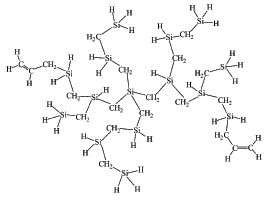|
|
Vol.
25 No. 3
May - June 2003
Solid
State Chemistry
by
Pavol Sajgalík and Milan Drábik
 |
|
AHPCS
"average" structure, as derived from NMR and GPC studies,
from the plenary lecture of Prof. L. Interrante.
|
The
IUPAC-sponsored International Conference on Solid State
Chemistry, held 7—12 July 2002 in Bratislava, Slovak
Republic, was the fifth conference in the series since 1986.
The original idea of the first conference organizers was to
bring together solidstate chemists from Western and Eastern
Europe in order to promote cooperation between the two-at
that time-divided groups. At the first Solid State Chemistry
Conference, held in Karlove Vary, Czech Republic, a kind of
nucleus formed that has grown over the years and resulted
in well-established meetings organized biannually, either
in the Czech or Slovak Republics.
Solid
State Chemistry 2002 (SSC02) was organized in the following
six sections:
-
advanced synthesis and characterization techniques of materials
- structure
and electron structure of solids
-
chemistry of glasses
-
novel inorganic materials
-
layered compounds, clathrates, and intercalates
-
deposited films and surface chemistry
These
sections covered almost all modern branches of solid-state
chemistry, which attracted the interest of scientists and
almost as many producers of new materials and technologies.
One hundred sixty-eight participants from 26 countries and
4 continents listened to 11 plenary, 12 keynote, and 83 lectures.
During the conference 117 posters were also presented. The
International Referee Board accepted a total of 103 papers
and these were published in Solid State Chemistry V, volumes
90 and 91, of the series Solid State Phenomena (available
from Scitec, <www.ttp.net>).
Prof.
Leonard Interrante, representing IUPAC, presented an overview
of IUPAC activities and delivered the plenary lecture on Si-Based
Ceramics from Polymer Precursors. Other plenary lectures covered
each topic of the conference, providing an excellent foundation
for the discussions and certainly serving as hints for further
developments in the field. Readers can gain an understanding
of the conference, its aims, and contents from short descriptions
of the plenary lectures and papers that are listed below.
The papers were published in Pure
and Applied Chemistry, Vol. 74, No. 11, pp. 2083—2168,
2002.
H.
Altenburg et al., Thick Films of Ceramic Superconducting,
Electro-Ceramic Materials. Thick films are made by low-priced
processes such as doctor blading, screen-printing, or spraying
methods, etc. These technologies and the fabricated thick
films of thermoresistive and superconducting materials are
discussed.
L.
Benco et al., Catalytic Conversion of Hydrocarbons
in Zeolites from First Principles. The conversion of hydrocarbons
over zeolites is an important industrial process. In order
to examine reaction pathways, both static and molecular dynamics
density functional theory calculations have been performed.
S.
Hoste et al., Nonvacuum-Based Deposition Techniques
for Superconducting Ceramic Coatings. The development of the
new generation of deposition methods, which are based on deposition
under atmospheric environment and from aqueous precursor materials,
is a real challenge for the community of solid-state chemists
and delineates the subject of this overview.
L.
Interrante et al., Si-Based Ceramics from
Polymer Precursors. The paper is focused on the SiC precursor
–AHPCS, which has also been used recently, along with
other polymeric precursors, to make two-phase (SiC/C and SiC/BN)
amorphous ceramics exhibiting unusual microstructures and
thermal/mechanical properties; SiC/C composites exert high
oxidation resistance, and microindentation tests on the SiC/BN
system suggest unusual toughness.
L.
Nemec, Engineering and Chemistry of the Glass
Melting Process. Improved glass-melting technology, process
control, glass quality control, and establishing novel melting
conditions are realized by different kinds of physicochemical
models, these are represented by systems containing melt and
numerous inhomogeneities (solid particles, bubbles).
A.
Ray, Hydrothermally Treated Cement-Based Building
Materials: Past, Present, and Future. The paper illustrates
the strength of thermal methods, especially when combined
with other analytical techniques, in the understanding of
hydrothermal reactions.
P.
Sajgalík, Importance of Chemistry in
High-Tech Ceramics Design. This paper deals with the role
of chemistry in the design of high-tech ceramic materials;
grain boundary composition of polycrystalline ceramics dictates
the hardness fracture toughness and creep resistance of liquid-phase
sintered silicon nitride and silicon carbide materials.
J.
W. Stucki et al.,
Effects of Iron Oxidation States on the Surface and Structural
Properties of Smectites. The oxidation state of iron in the
crystal structure of smectite clay minerals profoundly alters
their physical- chemical properties. Recent studies clearly
reveal that the surface chemistry of the clay is also affected,
which alters clay-water and clay-organic interaction mechanisms.
F.
Varret F et al.,
Examples of Molecular Switching in Inorganic Solids, Due to
Temperature, Light, Pressure, and Magnetic Field. Authors
describe various molecular switching processes occurring in
several types of inorganic solids: spin cross-over compounds,
photomagnetic Prussian blue analogs, and valence-tautomeric
system. A common description of their static properties by
a two-level model is given.
The
International Conference on Solid State Chemistry 2004 will
be held in Prague, Czech Republic, during the summer of 2004.
For
more information, contact <[email protected]>
or <[email protected]>.
Pavol
Sajgalík, chairman of SSC 2002, is director of the
Institute of Inorganic Chemistry, Slovak Academy of Sciences.
Milan Drábik, vice-chairman of the conference, is a
professor at the same institution.
Page
last modified 29 April 2003.
Copyright © 2002-2003 International Union of Pure and
Applied Chemistry.
Questions regarding the website, please contact [email protected]
|